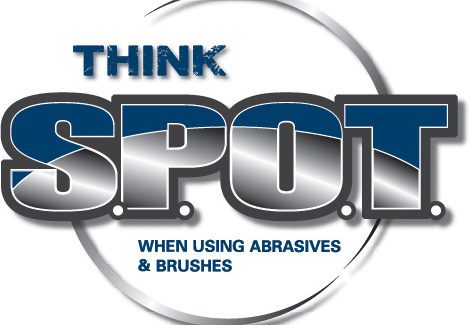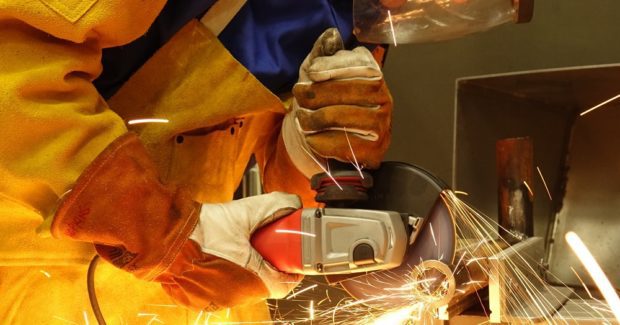On the SPOT: How to Improve Safety When Using Power Tools and Accessories
Here are some basic rules to follow for safely operating right-angle grinders, flap discs, die grinders and cutoff wheels, or other handheld tools and accessories. That’s not all: you’ll save some time and money too.
Posted: July 1, 2017
When using handheld tools and accessories, such as right-angle grinders, flap discs, die grinders and cutoff wheels, following some basic safety rules results in safer conditions for the tool operator. They can also contribute to cost savings through improved productivity and extended consumable life. Keep in mind the SPOT factors: speed and size, pressure, orientation, and time. SPOT factors not only play a role in safe tool usage and limit the potential for injury, they can also help improve tool life and efficiency to save time and money.
SPOT Factor One: Speed and Size
Matching the speed and size of the accessory to the speed and size of the tool is critical. It ensures that the accessory, such as a brush or wheel, is not larger than any of the guards placed on the tool. Mismatching the accessory and the tool may make it more likely for someone to remove the guard, which can negatively impact safety. Tool and accessory speed ratings that are compatible also benefit safety and performance. An accessory may fit on a specific tool, but that does not mean it was designed to be safely used on it. Make sure the accessory’s rpm rating meets or exceeds the recommended rpm rating of the tool. A tool turning at a higher rpm than the accessory rating can result in accessory failure and potential operator injury. Some tools or accessories don’t have a visible rpm rating stamp . . . perhaps it has worn off or is unreadable. These should not be used because it is impossible to ensure that the accessory is properly rated for the tool speed.
SPOT Factor Two: Pressure
Using the appropriate pressure for handheld power tools and accessories contributes to safe usage. With any handheld tool, the more pressure applied by the operator, the greater the opportunity for slipping or injury. Pushing harder to get the job done can also lead to greater operator fatigue. Using too much pressure also greatly reduces the life of accessories, which is costly and inefficient. With a wire brush, for example, excessive pressure puts too much force on the wire tips and filaments, which can lead to long wire breakage. So how can you gauge the appropriate amount of pressure? In many cases, the weight of the tool is sufficient pressure when you’re using the proper accessory at the appropriate speed.
SPOT Factor Three: Orientation
Using a tool or accessory at the proper angle to the workpiece is another factor contributing to safety. Proper orientation varies, since different tools often require different orientations to the workpiece. A grinding wheel and a wire wheel should not be used at the same angle, for example. The tips of a wire brush are designed to do the work by striking the base material, so proper brush angle accommodates using only the wire tips. Holding a brush at an incorrect angle may use the sides of the wires instead of the tips, which doesn’t provide good cleaning action and is inefficient. Similar results can occur when using a flap disc at an improper angle. If the operator is not using the entire work surface of the flap, it’s inefficient and can lead to premature product wear and excessive accessory replacement. Most flap discs work best at an angle of 15 deg to 30 deg. When the angle is too great, the operator isn’t using the entire work surface. Too low of an angle has potential for kickback, making it harder for the operator to control the tool.
SPOT Factor Four: Time
Maximizing product life helps operations get the most efficiency out of the product investment and labor time. However, using an accessory for too long can lead to safety issues and poor product performance. As one example, the diameter of a grinding wheel gets continually smaller with natural wear as it’s used. A smaller wheel loses efficiency and becomes harder to control, so wheels should be changed out prior to these control issues occurring. With wire brushes, long wire breakage is a sign to stop using a brush. Look for signs of wear for each accessory or tool to determine the time for replacement. Invest in high quality, heavy duty products for tougher jobs, to gain a longer life span and greater efficiency and to lesson downtime for changeover.
Remember to follow the manufacturer’s safety instructions for all handheld power tools and accessories, and inspect the tool or accessory each time it’s used. Look for signs of wear or damage. Each operator plays a role in making sure safe practices are always being followed. Paying attention to speed and size, pressure, orientation, and time helps ensure safety. It can also save time and money for the operation.






